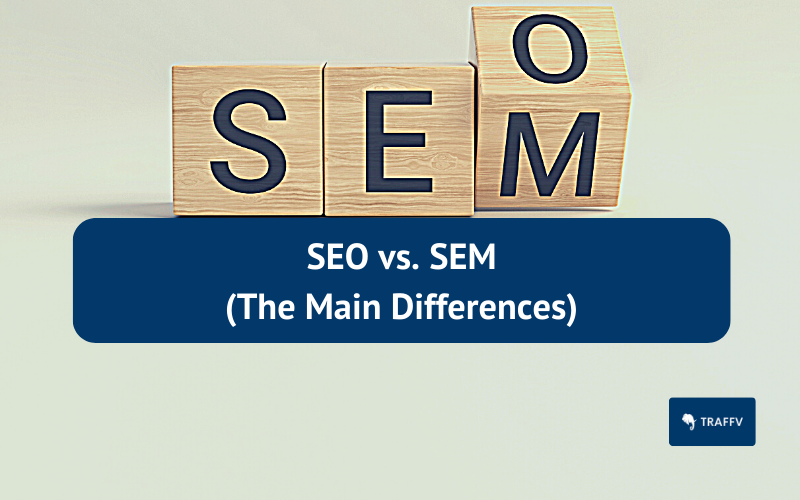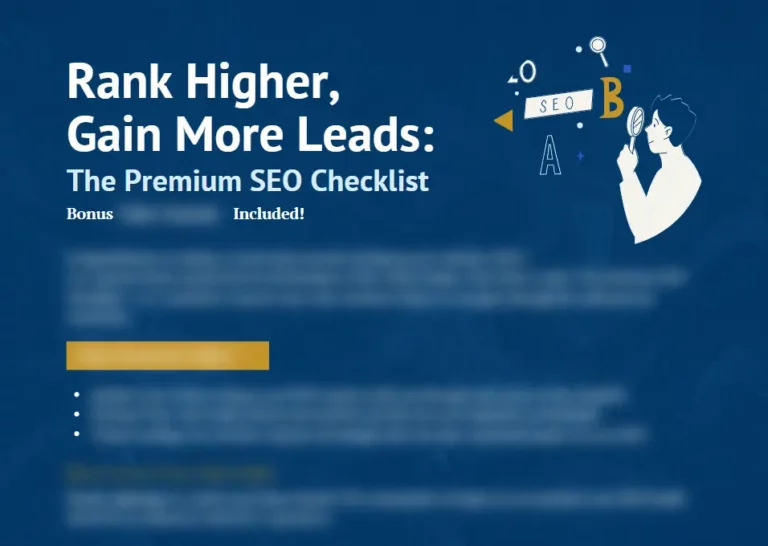The difference between SEO and SEM is that search engine optimization (SEO) focuses exclusively on driving organic traffic, while search engine marketing (SEM) involves getting traffic from both organic search and paid search advertising (PPC).
- You go with SEO when you expect to work on long-term organic traffic growth.
- You go with PPC when you plan to advertise your products/services right away.
- You go with SEM when you want a marketing strategy that includes SEO and PPC.
In the digital marketing space, there are 100s of terms for social media, content marketing, search engines, email marketing, and who knows what else after we publish this post.
We know how tricky it is to learn and look at all these unintelligible industry jargon and fancy words and wonder, “What have I done? Send help, please.”
But don’t worry, we’re here to help you with all things search engines.
Two of the most common acronyms you’ll hear are SEO and SEM.
Though they may sound similar, they’re not the same.
So what’s all this SEO vs. SEM pseudo-rivalry about?
Let’s find out.
What are SEO and SEM?
SEO, or search engine optimization, is the process of optimizing a website for search engines to rank in the organic search results.
And SEM, or search engine marketing, combines SEO with paid advertising (PPC) to also rank in search engine result pages (SERPs).
What is SEO, and how does it work?
When you want to find something online, you type a keyword or phrase into Google’s search bar.
The algorithm then scans billions of indexed websites to deliver the most relevant search results to your search queries.
The higher your site appears in the SERP, the more likely people are to click on it—and that’s where SEO comes in.
Optimizing your website content for specific terms and keywords can make you rank higher in SERPs and drive organic (unpaid) website traffic.
Some of the most common SEO techniques include things like:
- Optimizing title tag and meta description
- Creating keyword-rich content
- Using proper internal linking
- Enhance website speed and responsiveness
- Building backlinks from high-quality sites
It’s an ongoing process that takes time and effort to see results.
How do you optimize different web pages for search engines?
With these:
Keyword research
If you’ve ever wondered how Google knows what you’re looking for when you type in a query, keyword research is the answer.
Keyword research is how you find and analyze the words and phrases people use when searching for information online.
You can use it to develop content ideas, improve web usability, and boost PPC campaigns.
Understanding what searchers are typing on Google helps businesses better match their content and products/services to customer needs.
And by adjusting their website for those keywords, they have more chances of winning any of the first page slots.
The key is to think outside the box and come up with angles to find the right keywords.
Google Keyword Planner is an excellent tool for free keyword targeting.
For example, let’s use it for the “portable air conditioner” keyword.
As you can see, it gives you insights on…
- Avg. monthly searches – The average number of times people search for that keyword and similar terms based on a month range.
- Three-month change – It shows changes in search trends by comparing the latest month’s data to the previous two months’ data.
- YoY change – The year-on-year rate compares the monthly search volumes of the last month with the same month of the previous year.
- Competition – Level of keyword competition for ad placement. Low, medium, or high are all determined by the number of advertisers bidding on that keyword.
- Ad impression share – These are the impressions you get divided by the total searches for the location and network you’re targeting.
- Top-of-page bid – It shows the lower and higher range of what advertisers have historically paid for a keyword’s top-of-page bid based on location and settings.
This is the ideal resource if you’re into paid search results or just getting started with keyword research.
In case you’re serious about SEO and want to take it a step further, Ahrefs is a professional (paid) tool we highly recommend and use daily.
The basic subscription starts at USD$99 (around SGD$140), and it’s 100% worth the investment, considering all the valuable data that is given away.
With the exact same keyword, “portable air conditioner,” look at all this information.
- Keyword difficulty – It measures how challenging it would be to achieve a top-ten spot in the organic search results for any given keyword on a 100-point scale.
- Search volume – The average monthly searches for a keyword over the last 12 months.
- Traffic potential – It’s the organic traffic your target keyword’s number one ranking page gets from all other related keywords it ranks for.
- Global volume – This is how many times per month (on average) people search for the target keyword across all countries in Ahref’s database.
And this is just a portion of the keyword analysis that also includes Keyword ideas (Terms match, Questions, Also rank for, and Also talk about) as well as a Position history and a SERP overview to get more context on what type of content is ranking for that term.
On-page SEO
Once you’ve selected your specific keywords, you’ll need to integrate them into your website naturally and strategically.
This means sprinkling keywords in headlines and throughout the body of your text, as well as in title tags, meta descriptions, and alt-text of images.
On-page SEO is optimizing your website’s content and information architecture to make it as search-engine-friendly as possible, ensuring that your web pages are relevant to the keywords you want to rank for and that they’re well-structured and easy to navigate.
For example, Singapore Car Rental has a great on-page SEO.
Why?
Take a minute to walk through their home in a new tab quickly.
Did you notice?
All over the page, they’re targeting terms like:
car rental in singapore, car rental service, car rental services, car rental, car lease, car lease in singapore, budget car rental services, budget car rental service in singapore
These keywords were placed in headings, body text, buttons, and links.
Off-page SEO
Off-page SEO refers to the set of search marketing actions taken outside of your website to improve your rankings.
These activities involve social media signals, brand mentions, and link-building – links from other sites that act as a vote of confidence.
In other words, off-page SEO is all about building up your site’s reputation online.
Technical SEO
Site speed, mobile friendliness, structured data, and more are some of the things that technical SEO covers.
It’s the practice that helps search engines to crawl, index, and rank your website.
This is more important for ecommerce SEO as ecommerce stores usually have more technical errors.
What is SEM, and how does it work?
SEM is not free like SEO—or at least, not entirely.
That’s because paid ads (PPC) are part of SEM.
Paid ads are purchased through an auction system, where you bid on keywords relevant to your product or service.
The higher your bid and the stronger your Quality Score (relevancy of the ad to landing page + ad click-through rate), the higher chance your ad will be displayed.
SEM tactics tend to vary depending on which platform you use—since each one offers its own unique features—but some common methods are:
- Creating compelling ad copy
- Crafting effective negative keywords lists
- Targeting long-tail keywords
- Using callouts and site links
- Testing different ad placements
- Bidding strategically on keywords
Depending on where you want to advertise in Singapore, you may also have access to additional features like call and review extensions.
Differences between SEM and SEO
As we said earlier, the difference between SEM and SEO is that SEM entails gaining traffic from paid search advertising (PPC) and organic search results, while search engine optimization (SEO) is only about generating organic traffic. Nothing else.
SEO is a subset of SEM.
Of course, there are a couple of other SEO vs. SEM differences, such as:
- SEO takes 3-12 months to show results. PPC in a matter of days/weeks.
- SEO doesn’t work that well for time-sensitive promotions like Black Fridays.
- SEO is significantly more affordable and cost-effective in the long run than PPC.
- SEO does a better job ranking for low-difficulty informational keywords.
Now it’s time to dive into some details, shall we?
1. SEO takes 3-12 months to show results. PPC in a matter of days
With an SEO Agency, you’re looking at a 3-12 month timeline.
On the other hand, PPC can start generating clicks and conversions immediately.
This is because SEO is a long-term path focusing on adjusting your website to rank higher in SERPs over time.
While SEO can be time-consuming, it’s more sustainable and has long-lasting results.
So if you’re looking for a fast way to get traffic, PPC is the way to go.
But if you’re patient and willing to wait for results, then SEM (a mix of both) is worth the investment.
2. SEO doesn’t work that well for time-sensitive promotions
SEO takes too long to do something about the relevant keywords to your campaign, so by the time your SEO efforts have paid off, your campaign will be over.
With a PPC-oriented SEM strategy, you can immediately target relevant keywords and see results.
That being said, SEM is not a silver bullet – if your special offers or promotions aren’t relevant to the keywords you’re targeting, you will not see much success.
3. SEO is significantly more affordable in the long run than PPC
Price is always a factor, and SEO vs. SEM is no exception.
If your PPC campaign is particularly effective, it could end up being more affordable than SEO in the short term.
But in general, an SEO campaign provides better bang for your buck over time.
So if you have a tight marketing budget and looking to get the most ROI possible, SEO is your smart bet.
The average return on investment of SEO and PPC is ~100-200%, with the only difference being that the minute you stop paying for PPC, that ROI is completely gone.
With SEO, you’re investing in something that’ll help your website rank higher in Google.
This means that potential customers are more likely to find you organically.
You don’t have to pay for advertising, and you can still get qualified traffic to your site.
There’s nothing wrong with paying for advertising, but remember that you must have a consistent ad budget as long as you want to maintain your position.
4. SEO does a better job ranking for informational keywords
Here’s the thing: both SEO and PPC are SEM methods.
And while they share some similarities, there are also some key ways in which they differ.
One of these most significant differences is in terms of ranking.
Generally speaking, SEO ranks better for low-difficulty informational keywords than PPC, which is more suitable for insanely popular hard-to-rank keywords.
How do SEO and SEM work together?
We want to clarify one thing.
For some reason, there’s a common misconception about SEM being seen only as paid ads and nothing else just because it’s not organic.
Once again, SEO and PPC ads are part of SEM.
Want a formula? SEM = SEO + PPC.
So a better question would be: How do SEO and PPC work together for an SEM strategy?
Most marketing funnels and customer journeys are composed of three main stages, TOFU, MOFU, and BOFU:
- Top of the funnel (TOFU) for awareness
- Middle of the funnel (MOFU) for consideration
- Bottom of the funnel (BOFU) for conversion
With SEO and PPC, you target people at different stages of that journey.
Let’s imagine the following for a minute…
Someone urgently needs a plumber to fix their running toilet.
This person does a search, and the first thing they come across are ads.
Then more ads within the Google Business Profile listings results.
And finally, organic results.
This particular order is given by the search intent of the “plumber singapore” keyword, which is a transactional yet local intent ideal for PPC.
When you’re looking for plumbers, you’re interested in knowing services nearby, prices, availability, and so on.
Now, if another person, who doesn’t need immediate help but wants to fix a toilet bowl choke, finds one of your guides (thanks to SEO) on Why Does My Toilet Bowl Choke, you’ll be top-of-mind as the expert for this prospect.
They don’t buy today, but they might tomorrow.
Here’s the best part—and the end of the example, if somebody decides to hire a plumbing service and sees your business in the ads (PPC), in the organic results (SEO), and overwhelmingly everywhere else, you’re likely to become the go-to option for that searcher.
What happens exactly?
SEO and PPC complement each other by maximizing click-through rate (CTR).
Therefore, this dramatically increases your chances of making new business/sales.
The two of them share the common goal of driving traffic to a site, but they differ a little in tactics, implementation, and cost.
Is Google Ads SEM or SEO?
Google Ads is part of SEM because it’s an online advertising platform.
And one thing is for sure, if you have to play the pay-to-win game, then it’s not SEO.
Like Facebook and Instagram Ads, Google Ads falls into the advertising category—away from something organic.
SEO, on the other hand, is all about organic search results.
This means optimizing sites and content to rank higher in the unpaid, natural, and sought-after SERPs.
There’s a lot of overlap between SEO and Google Ads PPC, but they’re not exactly the same.
Is SEO cheaper than SEM?
Given the fact that there’s no SEO vs. SEM because SEM encompasses SEO and PPC, we can say that SEO alone is cheaper.
Now, “How cheap is it?” you might be wondering.
In Singapore, quality SEO prices range between S$1,500 to S$3,000 per month, whereas the bare minimum for a full SEM pro service is S$5,000+, according to Clutch 2022 Reviews.
That makes SEO 30-60% cheaper than SEM.
That said, SEO is not a one-time investment; it’s an ongoing process that requires regular attention and tweaking.
Although paid traffic from search engines can be more immediate and generate more leads in the short-term, organic traffic is much more valuable because it’s long-lasting and sustainable.
It all boils down to your goals and what you’re trying to achieve.
Summary
Now that you know the difference between SEO and SEM, we hope you’re better equipped to decide which is right for your business.
If you need help growing your website organically, Traffv can assist you with all your SEO needs.
Check out our SEO services!




